CVT stands for Continuously Variable Transmission. It's a type of automatic transmission that's become increasingly popular on a wide range of vehicles, particularly small to midsize crossovers and small to midsize cars.
Known for their improvements to fuel economy, CVTs don't have gears like a traditional automatic transmission. Instead, they use a pair of pulleys connected by a belt that continuously adjust, depending on engine speed.
Pros of a CVT
There are plenty of pros for CVT transmissions. Vehicles that use a CVT are among the most fuel-efficient vehicles on the market. This is because they can continuously adjust the engine speed to match the vehicle's speed perfectly, without wasting gas holding too high or too low of a gear, like an automatic gearbox might.
It is not uncommon to see gasoline-powered, non-hybrid midsize family sedans offering up to 38 MPG, partially thanks to their use of this transmission type. With government regulations requiring increased MPG and lower emissions, CVTs efficiency and lightweight help automakers meet those goals. Car companies are increasingly choosing CVTs for their lower engineering and manufacturing costs, lighter weight, and ability to stretch fuel mileage.
Many hybrid vehicles also use CVTs to transfer power to the wheels, rather than traditionally geared transmissions. This allows them to achieve greater MPG and fully take advantage of their efficient powertrains.
The seamless shifting and instant power are other benefits of a CVT. Drivers will often notice this when driving up an incline. Instead of feeling a distinctive downshift from an automatic, the CVT will quickly find the ideal ratio to give the vehicle enough power to make it up the incline. This also allows CVT vehicles to provide very smooth rides as there's no shifting feeling. This perfect matching of engine power and road conditions may feel strange but is more efficient.
Cons of a CVT
Some consumers -- who are used to the feeling of specific gear changes from their automatic transmissions -- don't like the feel of a CVT. A common complaint is that they give the vehicle a "rubber band" effect of constant acceleration or deceleration, depending on how the driver is pushing on the gas pedal.
Automakers have recently started to counter this feeling by programming into the CVT false "shift points" that mimic the shifting behavior of a traditional automatic.
During hard acceleration -- like an onramp or a steep hill -- CVTs can also push the engine to rev higher and louder than many consumers are used to. This can be off-putting if you've never experienced it before. This also contributes to the reputation of CVT-equipped cars as having louder interiors.
In terms of reliability, some CVTs don't last as long as the average automatic transmissions, and they can come with a large repair tag when they do fail.
Some CVTs might not even make it to 100,000 miles. Furthermore, when they fail, they typically can't be rebuilt but must be completely replaced. The main reason for this is that the parts typically fail with too much damage for a repair to be feasible.
Finally, a CVT cannot stand up to the demands of a high horsepower vehicle, so they're not used on performance vehicles and are usually not used on bigger-displacement engines (like V8s) at all. Though not common in high-performance vehicles, the Subaru WRX is available with a CVT. The 2021 Nissan Maxima V6 is also equipped with a CVT, which combines the company's Xtronic CVT with a 300 horsepower, 3.5-liter V6 for a blend of sportiness and fuel economy.
Should I Choose a CVT?
In most cases, consumers don't even have a choice about whether to opt for a CVT on the vehicle they're interested in. Automotive manufacturers offer either a CVT or a conventional automatic transmission, but not a choice.
The best idea is to choose your ideal vehicle based on other priorities. If it has a CVT, make sure you pay attention to the transmission's performance during your test drive to ensure it's something you can live with on a daily basis.
If you're on the fence, remember that CVT-equipped vehicles often have better fuel economy, so do the math to figure out how much you could save in fuel costs over your ownership of the vehicle. Just make sure you're willing and able to follow the recommended maintenance schedules of the CVT -- and in fact the entire car.
What Is a Continuously Variable Transmission (CVT)?
Even though continuously variable transmissions have been in use since 1989, it's only recently that they have become common in passenger cars and crossover SUVs. If you are car shopping for the first time in a while, the CVT may be a new term to you vs. the previous standard automatic and manual transmission options.
As previously stated, a CVT is a type of transmission that does not use a fixed set of gears like a traditional automatic. The most common type of CVT works by using a pair of pulleys that are connected to each other by a belt. One of the pulleys is connected to the engine, via a torque converter or clutch, while the other pulley connects to the wheels, where it sends power to move the vehicle.
The pulley width adjusts depending on how much power is needed, keeping the vehicle in the proper power range for the driving conditions. One pulley grows bigger and the other gets smaller, allowing for virtually unlimited "gear ratios." This allows a CVT to offer powerful and seamless acceleration without the sometimes abrupt feeling of changing gears.
The pulleys don't actually get larger, they consist of two cone-shaped halves which move closer together or further apart. When the halves are closer, the belt rides further up the cone, and the pulley is behaving as a larger gear. When the pulley halves move apart, the belt is closer to the center of the pulley, behaving like a smaller gear. Because the length of the belt never changes, the two pulleys must work in concert to ensure there is never slack in the belt. The belt also has a V shape, which allows the smooth movement up or down the pulley as its halves adjust.
There is another type of CVT, called a Toroidal CVT, that operates on a series of discs and rollers. This type is much less common than the pulley system. Rollers pivot on input and output discs, changing their relative ratios allowing for high torque, low-speed driving, or higher speeds where lower torque is required. Nissan used a pair of these Toroidal setups in a CVT for the JDM Cedric sedan, which they said better handled the torque output of the six-cylinder engine.
There are actually a couple more types of CVTs, but those are largely reserved for agricultural and commercial uses. If you are looking at a vehicle equipped with a CVT, it is most likely a pulley-based system.
Despite the lack of gears on a CVT, some systems do allow for manual shifting, or rather an approximation thereof. In this case, the pulley and belt system "shifts" to preset points to simulate the driving experience of changing gears. Some manufacturers program CVTs to mimic more traditional types of transmissions to give the driver the familiar sensation of shifting, even when not in manual mode.
An even more modern take on the system is found on some Toyota and Lexus vehicles. These use a conventional gear to start the car moving up to 25 MPH, before switching to the gearless CVT setup for the rest of the driving process. This "launch gear" allows cars like the new Corolla to get up to speed from a stop with a more consistent and smooth feel.
How are CVTs different?
Automakers are using CVTs in their cars a lot more these days for a few reasons.
The most common reason is that they offer better fuel economy. CVTs are lighter than a normal transmission and they can more closely match the engine speed to the vehicle speed, resulting in less wasted fuel.
This is also why most hybrid vehicles are equipped with CVTs.
CVTs are also able to extract maximum engine power out of smaller motors, which gives crossovers and small passenger cars quick and responsive acceleration. This is also why CVTs are most often found in vehicles with four-cylinder engines. Subaru was one of the first automakers to use CVT and now most vehicles across their lineup are shifting to CVTs. From the compact Impreza, to the midsize Subaru Outback, and even the three-row Ascent SUV.
CVTs also deliver uninterrupted acceleration without the typical pause for shifting. This step-less shifting also means there's no sudden downshifting when the vehicle needs more power to climb a hill. The elimination of the searching feeling when the transmission is trying to find the right gear for a particular situation can be unnerving to some drivers but is more efficient.
CVTs are an alternative to adding more gear ratios to a transmission. As fuel efficiency requirements become higher, manufacturers are increasing the number of gear ratios in modern transmissions. Now eight and 10-speed automatics are becoming common. CVTs are able to equal transmissions with higher gears, but with fewer moving parts, making them less expensive and lighter.
Are CVTs Less Reliable?
CVTs do have some inclination for mechanical issues and any repairs can be expensive, but this is also true for a standard automatic transmission. Some of the common problems associated with CVTs include overheating, jerking, slipping, and an abrupt loss of acceleration. There are also cases where the CVT has failed entirely. The belt that runs the CVT may be prone to stretching and becoming overly worn. Some automakers have even faced lawsuits from car owners over unreliable and faulty CVTs.
Like any transmission, it's important to monitor CVTs for signs of trouble. Checking transmission fluid to make sure it is not darkening and is at the proper level, can keep you away from the service department for costly transmission repairs. It's important to follow the guidelines for transmission services spelled out in your owner's manual. With proper monitoring and upkeep, CVTs can be as reliable as traditional automatic transmissions.
Which Vehicles Have CVTs?
Simply looking at the interior of a vehicle won't be enough to tell you if the vehicle is equipped with a CVT. The shifting mechanism available to the driver looks identical to that on a regular automatic transmission.
Currently, CVTs are most common on small to midsize cars and crossovers, particularly from Japanese brands like Nissan, Subaru, or Mitsubishi. Toyota and Honda are also starting to put CVTs in more vehicles in their lineup.
You're far more likely to find them when looking at Japanese automakers versus American or European. You won't find a CVT in a current Audi, BMW, Fiat, Jaguar, Mercedes-Benz, Land Rover, or Volkswagen. From American automakers, CVTs are largely found in only their compact like the Chevrolet Spark or hybrid vehicles like the Ford Escape Hybrid and upcoming Maverick Hybrid pickup truck.
Typically some quick research on the model you're eyeing will tell you if the vehicle has a CVT. In many cases, it is the standard transmission with no option for an automatic or manual.


